Volvo XC60: City Safety
Introduction
City Safety™1 is a support system designed to help the driver avoid low speed collisions when driving in slow-moving, stop-and-go traffic.
City Safety™ is not active if your vehicle’s speed is below approximately 2 mph (4 km/h).
This means that City Safety™ will not react if your vehicle approaches another vehicle at very low speed, for example, when parking.
The function is active at speeds up to approximately 18 mph (30 km/h) and assists the driver by applying the brakes automatically, thereby avoiding or helping to reduce the effects of a collision.
City Safety™ is designed to intervene as late as possible to help avoid unnecessary activation.
City Safety™ triggers brief, forceful braking if a low-speed collision is imminent. However, the system will not intervene in situations where the driver actively steers the vehicle or applies the brakes, even if a collision cannot be avoided.
This is done in order to always give the driver’s actions highest priority.
City Safety™ activates in situations where the driver has not applied the brakes in time, which means that the system cannot help the driver in all situations.
City Safety™ should not be used to alter the way in which the driver operates the vehicle.
The driver should never rely solely on this system to safely stop the vehicle.
Normally, the occupants of the vehicle will not be aware of City Safety™ except when the system intervenes when a low-speed collision is imminent.
If the vehicle is also equipped with the optional Collision Warning with Full Auto-brake and Pedestrian Detection system, the two systems interact. For more information about the Collision Warning with Auto-brake system, see page 172.
WARNING
• City Safety™ is a supplemental aid to
the driver. It can never replace the
driver’s attention to traffic conditions or
his/her responsibility for operating the
vehicle in a safe manner.
• City Safety™ does not function in all
driving situations or in all traffic, weather
or road conditions.
• City Safety™ only reacts to vehicles
traveling in the same direction as your
vehicle and does not react to small vehicles,
bicycles or motorcycles or to people
or animals.
• City Safety™ is not activated when your
vehicle is backing up.
• City Safety™ functions at speeds up to
18 mph (30 km/h). This system can help
prevent a collision if the difference in
speed between your vehicle and the
vehicle ahead is less than 9 mph
(15 km/h). If the difference in speed is
greater, a collision cannot be avoided
but the speed at which the collision
occurs can be reduced. The driver must
apply the vehicle’s brakes for full braking
effect.
• Never wait for City Safety™ to intervene
in a potential collision situation. The
driver is always responsible for maintaining
a safe distance to the vehicle
ahead.
Function
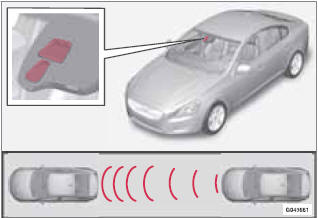
Location of the laser sensor in the windshield
City Safety™ monitors traffic ahead of you using a laser sensor mounted in the upper section of the windshield. If a collision is imminent, City Safety™ will automatically apply the brakes, which may feel like hard braking.
If the difference in speed between your vehicle and the vehicle ahead is more than approximately 9 mph (15 km/h), City Safety™ alone cannot prevent a collision from taking place.
The driver must apply the brakes to help avoid a collision or reduce its effect.
When the function activates and applies the brakes, a message will appear in the information display to indicate that the system is/has been active.
NOTE
• When City Safety™ applies the brakes,
the brake lights will illuminate.
• In cases where City Safety™ has stopped
the vehicle, the system will then
release the brakes. The driver must
apply the brakes to keep the vehicle at
a standstill.
Using City Safety
NOTE
The City Safety™ function is activated automatically
each time the engine has been
switched off and restarted.
On and Off
In certain situations, it may be desirable to switch City Safety™ off, such as when driving in close quarters where leaves, branches, etc.
may obscure the hood and windshield.
When the engine is running, City Safety™ can be switched off as follows:
Press My Car in the center console control
panel and go to Settings
 Car settings
Car settings
 Driver support systems
Driver support systems
 City Safety.
City Safety.
Select Off.
If the engine is switched off, City Safety™ will reactivate when the engine is restarted.
WARNING
The laser sensor emits light when the ignition
is in mode II or higher, even if City
Safety™ has been switched off.
To switch City Safety™ on again:
• Follow the same procedure as for switching City Safety™ off but select ON.
Limitations
The sensor used by City Safety™ is designed to detect cars and other larger motor vehicles ahead of your vehicle in both daylight and darkness.
However, there are certain limitations and the laser sensor’s function may be reduced by, for example, heavy rain or snowfall, or by dense fog or thick, blowing dust or snow. Condensation, dirt, ice or snow on the windshield may also interfere with the sensor’s function.
Objects such as warning flags hanging from long objects on the roof or accessories such as auxiliary lights or protective arches on the front of the vehicle that are higher than the hood may also impede the sensor’s function.
Braking distance to the vehicle ahead increases on slippery road surfaces, which may reduce City Safety’s capacity to avoid a collision.
In situations like this, the DSTC system (see page 149) will help provide the best possible braking capacity and stability.
City Safety™ emits infrared light and measures the way in which the light is reflected. Therefore, vehicles or objects with low-reflective surfaces may not be detected. Normally, the license plate and taillight reflectors give the rear section of a vehicle ahead sufficient reflective surfaces to be detected.
NOTE
• Keep the windshield in front of the laser
sensor free of ice, snow, dirt, etc. See
page 168.
• Snow or ice on the hood deeper than
2 inches (5 cm) may obstruct the sensor.
Keep the hood free of ice and snow.
• Do not mount or in any way attach anything
on the windshield that could
obstruct the laser sensor.
Troubleshooting
If Windscreen Sensors blocked appears in the information display, this indicates that the City Safety™ laser sensor is obstructed in some way and cannot detect vehicles ahead of you, which means that the system is not functioning.
However, this message will not be displayed in all situations in which the sensor is obstructed.
For this reason, the driver must ensure that the area of the windshield in front of the sensor is always kept clean.
The following table shows some of the situations that can cause the message to be displayed and suggested actions.
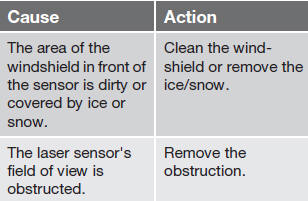
CAUTION
If a crack, scratch or stone chip should
occur in the section of the windshield in
front the laser sensor and covers an area of
approximately 1/50 x 1/10 in. (0.5 x 3 mm)
or larger, contact a trained and qualified
Volvo service technician to repair or replace
the windshield (see the illustration showing
the location of the sensor on page 168).
Failing to do so may result in reduced City
Safety™ functionality.
To help prevent reduced functionality,
please also observe the following:
• If the windshield is replaced, use the
same type or a windshield approved by
Volvo.
• When replacing windshield wipers, use
the same type or ones approved by
Volvo.
The laser sensor
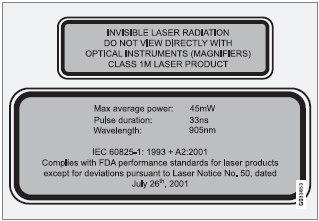
The upper decal describes the laser beam's classification and contains the following text:
Invisible Laser radiation – Do not view directly with optical instruments (magnifiers) – Class 1M laser product.
The lower decal describes the laser beam's physical data and contains the text:
IEC 60825-1:1993 + A2:2001. Complies with FDA performance standards for laser products except for deviations pursuant to Laser Notice No. 50, dated July 26th, 2001 The laser beam's physical data is listed in the following table:
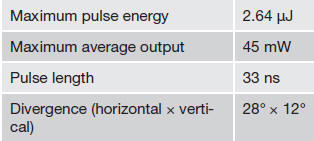
NOTE
The function of aftermarket laser detectors
may be affected by City Safety's laser sensor.
WARNING
The laser sensor emits light when the ignition
is in mode II or higher, even if City
Safety™ has been switched off.
WARNING
Eye injury may occur if any of the following
points are not followed:
• It is essential that all pertinent instructions
be followed when handling laser
instruments. Testing, repairing, removing,
adjusting and/or replacing any
components in the laser sensor may
only be done by a trained and qualified
Volvo service technician.
• Do not remove the laser sensor (including
removal of the lenses). A laser sensor
that has been removed belongs to
laser class 3B according to standard
IEC 60825-1. Devices in laser class 3B
present a risk of injury to the eyes.
• The laser sensor’s connector must be
disconnected before the sensor is
removed from the windshield.
• The laser sensor must be mounted in
place on the windshield before connecting
the sensor’s connector.
• Do not view the laser sensor (which
emits spreading, invisible laser beams)
with optical instruments from a distance
of less than 4 inches (100 mm).
Symbols and messages in the display
When City Safety™ automatically applies the brakes, one or more of the symbols in the main instrument panel may illuminate and its associated message will be displayed.
A text message can be erased by pressing briefly on the READ button on the turn signal lever.
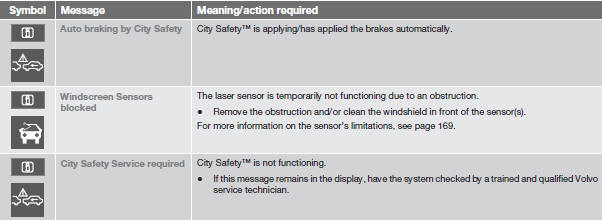
See also:
Seat belts
SEAT BELT PRECAUTIONS
WARNING:
All occupants of the vehicle must wear their
seat belts at all times. Seat belts and child
restraints reduce the risk of serious or fatal
injuries for all occupants in the event of a
collision or sudden stop. ...
Alarm system
The alarm system helps to protect your
vehicle and valuables from theft. The horn
sounds and the turn signal lights flash if
someone attempts to break into your
vehicle. The starter motor is also interrupted
to prevent starting the vehicle ...

 Distance Alert
Distance Alert